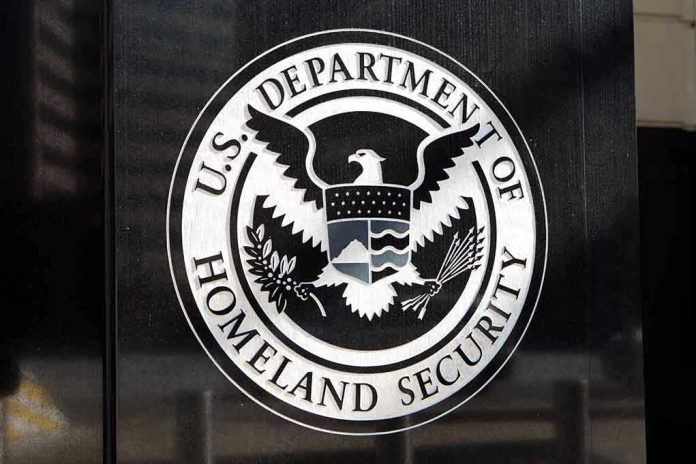
A Texas city manager’s off-the-cuff jab at DHS Secretary Kristi Noem—calling her ‘Homeland Barbie’ while his community reeled from deadly floods—has ignited a firestorm over the real priorities in disaster response and the out-of-touch optics of federal bureaucrats.
At a Glance
- Kerrville, Texas devastated by historic flooding; federal disaster declared and FEMA deployed
- Local city manager’s ‘Homeland Barbie’ remark about DHS Secretary Noem sparks national controversy
- Criticism mounts over perceived delays and bureaucratic mismanagement in federal response
- Community frustration grows as citizens demand fast, effective recovery—not media spectacles
Texas Flood Disaster Unleashes Tidal Wave of Federal Promises—and Local Frustration
Catastrophic flooding hammered Kerrville and surrounding Hill Country communities starting July 2, 2025, as up to 18 inches of relentless rain transformed neighborhoods into disaster zones. The devastation forced over 850 emergency rescues and left families stranded, homes ruined, and livelihoods upended. President Trump acted swiftly, issuing a Major Disaster Declaration on July 6, 2025, to activate the federal cavalry—namely, FEMA and the Department of Homeland Security. But while the paperwork moved, so did the waters, and patience wore thin on the ground as residents waited for real help—not just press conferences and polished statements.
Texas local official caught mocking DHS Secretary as 'Homeland Barbie' after deadly floods https://t.co/GqGUUgPSBk
— Fox News (@FoxNews) July 28, 2025
As FEMA trucks finally rolled in and DHS Secretary Kristi Noem issued pledges of support, the spotlight shifted from the disaster to the disaster response. The city manager of Kerrville, juggling a battered community and mounting desperation, reportedly referred to Secretary Noem as “Homeland Barbie” in a private exchange that somehow went public. Instantly, the comment became headline fodder: not just a jab at one federal official, but a symbol of small-town frustration with the entire bureaucratic circus that so often accompanies federal disaster relief.
Federal Aid Arrives—But Community Skepticism Runs Deep
FEMA’s arrival in Kerrville brought promises of temporary lodging, home repairs, and infrastructure grants. Secretary Noem declared her agency “currently deploying federal emergency management resources to Texas first responders, and will work closely with state and local authorities to ensure the people of Texas get the support they need as search efforts continue and recovery begins.” But residents and local officials weren’t buying the shiny package. The wounds of past disasters—where aid was slow, promises went unfulfilled, and bureaucratic red tape strangled recovery—were still fresh. Texans expected more than declarations and photo ops. They wanted accountability, control, and a government that puts citizens’ needs ahead of political theater or media optics.
Governor Abbott, who has long battled federal agencies for respect and results, pressed Washington for faster action and more funding as he toured battered hospitals and neighborhoods. New grants were announced, additional counties added to the disaster declaration, and the machinery of government ground forward. Yet the gap between federal talking points and local reality remained stark. As FEMA continued distributing aid into late July, the slow drip of recovery efforts fueled skepticism that Washington—no matter who sits at the top—remains out of touch with the day-to-day agony of communities in crisis.
‘Homeland Barbie’ Remark Becomes a Rallying Cry for Accountability
The city manager’s “Homeland Barbie” comment—while dismissed as unprofessional by some—struck a chord with a public weary of bureaucratic pageantry. For many, it summed up the disconnect between polished federal officials and the grit of local responders working around the clock. The term became a rallying cry: a demand for less showmanship and more substance, for real-world solutions over staged empathy. While Secretary Noem and FEMA continued their rounds of statements and press briefings, the people of Kerrville and the wider Texas Hill Country reminded Washington that the measure of disaster response isn’t in the speeches or the headlines, but in how quickly families can return to their homes and rebuild their lives.
Past disasters have set a high bar for federal aid—and a low tolerance for anything that even hints at self-promotion or politics-as-usual. The “Homeland Barbie” quip, for all its controversy, captured a frustration that runs deep in communities who feel forgotten until the cameras roll. As this recovery drags on, Texans are watching closely to see if FEMA and DHS can turn their pledges into real progress—or if they’ll just keep spinning the same old PR lines while Main Street does the heavy lifting.
Disaster Politics: Who Pays, Who Benefits, and Who Gets Left Behind?
The aftermath of the Hill Country floods is a test of government priorities. Local residents, first responders, and business owners face months—if not years—of rebuilding. Hospitals need funding, infrastructure needs repair, and families need to know they’re not just props in a federal photo op. The state of Texas, under Governor Abbott, continues to push for expanded federal assistance while keeping a wary eye on bureaucratic overreach and waste. The challenge ahead is clear: cut through the red tape, deliver real help fast, and make sure taxpayers see value—not vanity—in every federal dollar spent.
Experts in disaster management agree on one thing: communities recover fastest when local, state, and federal agencies work together—without ego, without delays, and without the sideshow. The “Homeland Barbie” saga may fade, but the question it raised remains: Will Washington finally learn to put citizens first, or will disaster relief keep getting lost in the noise of political spectacle and media spin?
Sources:
FEMA Activates in Texas Following President Trump’s Major Disaster Declaration
Governor Abbott Announces Four Counties Added to State Disaster Declaration
Kerr County: Texans Affected by Severe Storms and Flooding
Texas Division of Emergency Management: FEMA Update














